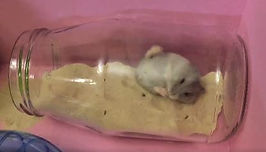A collaboration with
HYGGELIG PET PRODUCTS
(Online Shop)

HOW TO USE PAPER BEDDING
effectively & cost-saving
Paper-based bedding is the safest & number one choice around the world for hamsters.
Very easily available in SA these days, so there is no longer any excuse to still be using toxic pine shavings. Sadly, many rodent owners and pet shops remain under the impression that paper beddings are “too expensive”, and many are still reluctant to use or stock these products. Therefore, there clearly needs to be explanation of why & HOW to use it!
Paper bedding is not an upmarket product! You simply need to know how to use it.
Used properly, it is way less expensive than wood shavings!





MAINTENANCE COST WILL BE SIGNIFICANTLY LOW
It is very important that your hamster retains it’s own special scent within it’s habitat. If you remove all of this scent during cage cleans, your hamster will feel stressed and will have to go about remarking his/her territory to make it his/her own again.
-
Never discard the entire mass of paper bedding that your hamster has been living with!
-
Keep the top layer and cleanest sections and return it to the habitat after cleaning, and simply top up with some fresh stock (bits of old dried food, seed shells, and poop, will have filtered to the bottom layer and this is the only part you need to discard). You will therefore be going through way less bedding and the cost will be significantly less.
-
Only the initial set-up cost will be higher for a new hamster.
A SAND POTTY & POTTY-TRAINING HELPS
-
We always recommend that your hamster is provided with a sand bath/potty to clean itself and to pee in. Not only is it natural & healthier, but there will be less wasting of paper bedding.
-
If you do not provide a potty, or your hamster doesn't potty-train, the soiled patch will need to be removed on a daily basis. However, many of the paper beddings absorb urine & odours better than most wood shavings so it may take you a few days to find your hamster's pee spot.
-
Try to potty-train your hamster before putting in the recommended depth of the deep bedding zone.


HOW MUCH BEDDING?
-
There must be at least one suitably sized deep zone filled with paper bedding for burrowing & tunneling.
-
Recommended zone size: Depth of 30cm or more (minimum 25cm) spanning at least 1/3 to 1/2 the size of an average 5000cm2 habitat.
-
Even an amputee (tripod) will still burrow and require this depth.
-
COMPRESS THE BEDDING slightly as you keep adding. Fluffed up bedding doesn't hold tunnels very well and will collapse, so you will have to add more anyway.
-
The rest of the habitat should ideally consist of another one or two different other substrates for additional enrichment, e.g. sand, coco peat, Chipsi Super, etc. for the hamster to dig in but does not need to be as deep (10-15cm is ideal).
-
Otherwise if you don't have the additional substrates right now, the rest of the floor space can be covered with a shallower layer of the paper bedding.
-
The deep burrowing zone can either be piled up against the one side of the habitat, or contained by burrow box of sorts, or a barrier can be made as a wall out of cardboard, safely layered logs, perspex, paper clay wall (see the DIY page), etc. with access holes or ramps.
TIP: Wait until your hamster is fully potty-trained and using only his sand to pee in before giving him the full depth bedding zone, or he'll most likely burrow down to make a nest and will constantly pee there, causing extra work and bedding for you.
-
Once he's potty-trained, fill the deep zone to the recommended depth.
-
Even if he never potty trains, DO NOT DENY HIM THE RECOMMENDED DEPTH IN AT LEAST ONE ZONE! In this case, you will unfortunately go through more bedding than usual, but it is unfair to “punish” him for his own natural behaviour.




CLEANING
-
If you have the recommended size habitat for your hamster, including all the required accessories within, with a few minutes of nightly spot-cleaning you will only need to do major cage-cleans a few times a year, and this will keep your ham much happier than being completely disrupted every two weeks.
Big cleans will depend on the size, style, and location of your habitat:
-
If you have an exposed wire cage (not recommended), or a habitat in an area that gets a lot of dust, you will probably have to do a big clean about once every 2 to 3 months.
-
A PROPER HABITAT OR TANK will only need big-cleans about 2 or 3 times a year.
Amazingly, the bigger the habitat, the less often you will have embark on big cleaning sessions.
